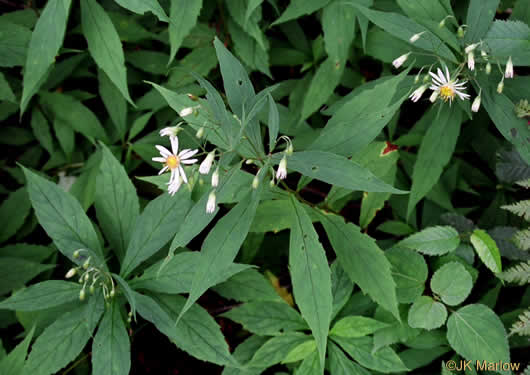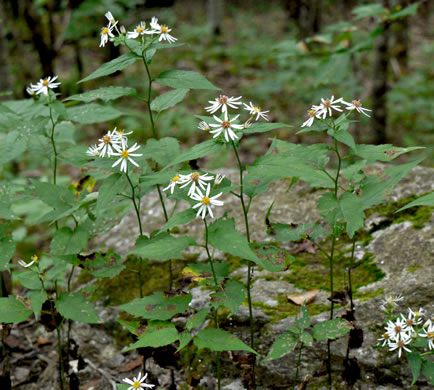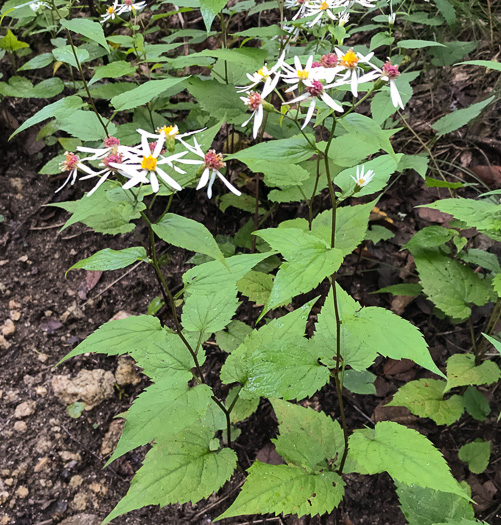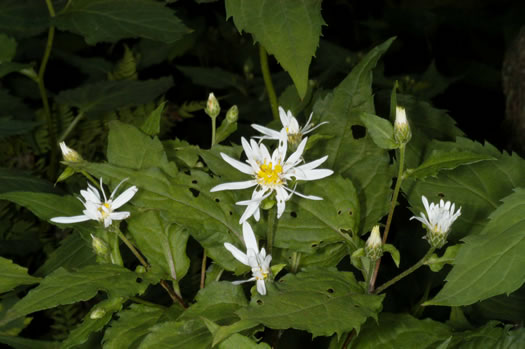Spermatophytes (seed plants): Angiosperms (flowering plants): Eudicots: Core Eudicots: Asterids: Campanulids: Asterales
WEAKLEY'S FLORA OF THE SOUTHEASTERN US (2/10/25):
Eurybia chlorolepis
FAMILY
Asteraceae
Go to FSUS key
Dig deeper at SERNEC, a consortium of southeastern herbaria.
Test-drive A Teaching Key to Asters.
Read more about Blue Ridge White Heart-leaved Aster at Vascular Plants of North Carolina.
SYNONYMOUS WITH
PLANTS NATIONAL DATABASE:
Eurybia chlorolepis
FAMILY
Asteraceae
SYNONYMOUS WITH Floristic Synthesis of North America. BONAP (Kartesz, 2021)
Eurybia chlorolepis
SYNONYMOUS WITH Flora of North America north of Mexico, vol. 19-20-21 (2006)
Eurybia chlorolepis
SYNONYMOUS WITH VASCULAR FLORA OF THE CAROLINAS (Radford, Ahles, & Bell, 1968) 179-47-006b:
Aster divaricatus var. chlorolepis FAMILY Asteraceae
INCLUDED WITHIN Gray's Manual of Botany (Fernald, 1950)
Aster divaricatus
SYNONYMOUS WITH Manual of the Southeastern Flora (Small, 1933, 1938)
Aster chlorolepis
COMMON NAME:
Blue Ridge White Heart-leaved Aster, Mountain Wood-aster
To see larger pictures, click or hover over the thumbnails.
JK Marlow jkm0508c_13
August Transylvania County NC
Blue Ridge Parkway
Leaves ovate to lance-ovate or the upper elliptic to lanceolate, acuminate, per Vascular Flora of the Carolinas (Radford, Ahles, & Bell, 1968).
JK Marlow jkm150814_731
August Jackson County NC
Whiteside Mountain
Usually found above 1200m (vs. A. divaricatus usually found below 1200m), per The Taxonomic Status and Probable Origin of Aster chlorolepis, a Southern Appalachian Endemic (Lamboy, 1992).
JK Marlow jkm180821_3997
August Jackson County NC
Whiteside Mountain
Longest peduncle in capitulescence > 1.5cm (A. divaricatus < 1.5cm), per The Taxonomic Status and Probable Origin of Aster chlorolepis, a Southern Appalachian Endemic (Lamboy, 1992).
JK Marlow jkm180821_4001
August Jackson County NC
Whiteside Mountain
![]() COMPARE
asters with heart-shaped leaves
COMPARE
asters with heart-shaped leaves
Patrick D. McMillan pdmechlorolep_whiteside1
Month Unknown Jackson County NC
Whiteside Mountain
Rays white, usually 10 or more, 1.5-2cm long, disc flowers yellow or red, per Vascular Flora of the Carolinas (Radford, Ahles, & Bell, 1968).
WEAKLEY'S FLORA OF THE SOUTHEASTERN US (2/10/25):
Eurybia chlorolepis
FAMILY
Asteraceae
SYNONYMOUS WITH
PLANTS NATIONAL DATABASE:
Eurybia chlorolepis
FAMILY
Asteraceae
SYNONYMOUS WITH
Floristic Synthesis of North America. BONAP (Kartesz, 2021)
Eurybia chlorolepis
SYNONYMOUS WITH
Flora of North America north of Mexico, vol. 19-20-21
Eurybia chlorolepis
SYNONYMOUS WITH
VASCULAR FLORA OF THE CAROLINAS (Radford, Ahles, & Bell, 1968) 179-47-006b:
Aster divaricatus var. chlorolepis
FAMILY
Asteraceae
INCLUDED WITHIN
Gray's Manual of Botany (Fernald, 1950)
Aster divaricatus
SYNONYMOUS WITH
Manual of the Southeastern Flora (Small, 1933, 1938)
Aster chlorolepis
If a search such as "Carex leptalea var. leptalea" doesn't deliver the results you want, try "Carex leptalea".
Or, to minimize chances of a misspelling, try just "Carex le".
Less is more: If "pencil flower" doesn't deliver the results you want, try "pencil".







